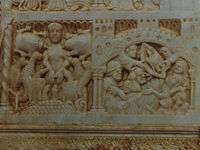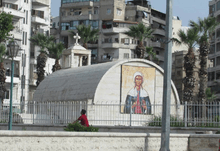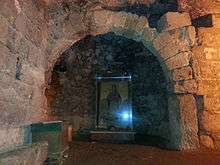Thecla
Thecla or Tecla (Ancient Greek: Θέκλα, Thékla) was a saint of the early Christian Church, and a reported follower of Paul the Apostle. The earliest record of her life comes from the ancient apocryphal Acts of Paul and Thecla.
Saint Thecla | |
|---|---|
 | |
| Virgin and Martyr | |
| Born | 30 AD Iconium (now Konya, Turkey) |
| Died | 1st century AD |
| Venerated in | Oriental Orthodox Churches Catholic Church Eastern Orthodox Church Episcopal Church Coptic Christianity |
| Feast | September 23 (Catholic Church, Episcopal Church (United States)) September 24 (Eastern Orthodox Church) Thout 23 (Coptic Christianity)[1] |
Church tradition
The Acts of Paul and Thecla is a 2nd-century text (circa AD 180) which forms part of the Acts of Paul but also circulated separately. According to the text, Thecla was a young noble virgin from Iconium who listened to Paul's "discourse on virginity", espoused the teachings and became estranged to both her fiancé, Thamyris, and her mother. She sat by her window for three days, listening to St. Paul and his teachings. When they witnessed this, they became concerned that Thecla would follow Paul's demand "one must fear only one God and live in chastity" and turned to the authorities to punish both Paul and Thecla.
Thecla was miraculously saved from burning at the stake by the onset of a storm and traveled with Paul to Antioch of Pisidia. There, a nobleman named Alexander desired Thecla and attempted to rape her. Thecla fought him off, tearing his cloak and knocking his coronet off his head in the process. She was put on trial for assault. She was sentenced to be eaten by wild beasts but was again saved by a series of miracles, when the female beasts (lionesses in particular) protected her against her male aggressors. While in the arena, she baptized herself by throwing herself into a nearby lake full of aggressive seals.[2][3]
She rejoined the Holy Apostle Paul in Myra, traveled to preach the word of God and became an icon encouraging women to imitate her by living a life of chastity and following the word of the Lord.[4] She went to live in Seleucia Cilicia. According to some versions of the Acts, she lived in a cave there for 72 years. However, she passed the rest of her life in Maaloula, a village in Syria. She became a healer, performed many miracles, but remained constantly persecuted. The story goes, as her persecutors were about to get her, she called out to God and a new passage was opened in the cave, and the stones closed behind her. The passage and caves are still found in Maaloula which became a very important site for pilgrims. She was able to go to Rome and lie down beside Paul's tomb.[5]
Traditions and interpretations
The Church Fathers recount a number of traditions about Thecla. Gregory of Nyssa writes in the 4th century (Homily 14 in Cant) that she undertook the sacrifice of herself, by giving death to the flesh [Gal 5:24], practicing great austerities, extinguishing in herself all earthly affections, so that nothing seemed to remain living in her but reason and spirit: the whole world seemed dead to her as she was to the world [Gal 6:14]. Macarius Magnes shortly after AD 300 wrote how the message of Christianity was "the Sword, [Matt 10:34] which cuts relations from each other [Matt:10:35], as it cut Thecla from Theocleia." [Apocriticus ii.7]. Around AD 280, Thecla features as one of the characters in Methodius of Olympus' Symposium, in which we learn that she was well versed in profane philosophy, and various branches of literature, of eloquent yet modest discourse. He says that she received her instruction in divine and evangelical knowledge from Paul, and was eminent for her skill in sacred science ("Logos 8").
The martyrdom of Thecla is frequently referred to in the earliest Acts of the Martyrs. Eugenius, a martyr of Trebizond under Diocletian (284–305), couples Thecla with David and Daniel in his prayers. The exordium of the Acts of Polyeuctes [d. 259] refers to Thecla and Perpetua, and there were certainly many virgin martyrs who drew their first inspiration from the same source. Eugenia of Rome in the reign of Commodus (180–192) is reported in the Acts of her martyrdom to have taken Thecla as her model.
Paul is also an ambiguous figure in the Acts of Paul and Thecla. He is seen as a preacher of asceticism, but one with whom women are besotted. His teachings lead Thecla into trouble, and yet he is never there when the trouble comes. This presentation of Paul as ascetic preacher, discouraging marriage, appears to be very different from that of the Pastoral Epistles. For instance, 1st Timothy 4:1–3 has Paul explicitly condemning anyone who forbids marriage. However, 1st Corinthians 7 is more ambivalent about marriage, saying that "it is well for a man not to touch a woman" (7:1). This text has been interpreted as ideologically closer to Paul and Thecla. In any event, Paul and Thecla indicates one possible understanding of Paul's legacy in the second century.
Veneration

In the Eastern Orthodox Church, the wide circulation of the Acts of Paul and Thecla is evidence of her veneration. She was called "apostle and protomartyr among women" and "equal-to-apostles in sanctity". She was widely cited as an ascetic role model for women. During the fourth and fifth centuries, Thecla was lauded in literature as an exemplary virgin and martyr by ascetic writers and theologians such as Methodius of Olympus, Gregory of Nyssa, and Gregory of Nazianzus. The Eastern Rites of the Eastern Orthodox Church commemorate her on 24 September in churches following the new Calendar and 7 October for those using the old or Julian Calendar.
Her veneration flourished particularly at Seleucia Cilicia (where she was said to have lived to old age and be buried), Iconium (present day Konya), and Nicomedia. The society also appeared at least as early as the 4th century in Western Europe. Chamalières in France was believed to hold relics. The obscure saints, Tecla of Aquileia and of Trieste are modeled after her.[6][7] In Bede's martyrology, Thecla is celebrated on 23 September, which was her feast day in the West, though in 1969 the Roman Catholic Church removed Thecla's feast day from the Calendar of Saints for lack of historic evidence.[8] The Western Rite Parishes of the Orthodox Churches continue to celebrate her on 23 September (new Calendar Parishes) and 6 October (old Calendar Churches).
A local martyr tradition of Thecla may have inspired an episode connected to Paul the Apostle. "It is otherwise difficult to account for the very great popularity of the cult of St. Thecla, which spread over East and West, and made her the most famous of virgin martyrs," wrote M. R. James, the editor of this Acta (James 1924).
Tomb of Saint Thecla, Silifke

The cave-tomb in Seleucia was one of the most celebrated in the Christian world. Gregory of Nazianzus withdrew to the shrine of 'the highly praised young maid Thecla'[9] for three years. The site was described by Egeria in the mid-380s. It was restored several times, among others by the Emperor Zeno in the 5th century, and today the ruins of the tomb and sanctuary are called Aya Tekla Church or Meriamlik.[10] A 5th century anonymous work, The Life and Miracles of Thecla concentrates on the town.[11]
Tomb of Saint Thecla, Maaloula

In Maaloula, Syria, a Greek Orthodox nunnery, the Convent of Saint Thecla, was built near her cave tomb, reached by steps in the mountainside, a pilgrimage site with a holy well. The Church tradition is that the mountain opened miraculously to protect Thecla from her persecutors.
On Monday, December 2, 2013, during the Syrian civil war, twelve nuns there were seized by Al-Qaeda radicals of Al-Nusra Front during the bombardment of her shrine. Three months later the nuns were exchanged for relatives of terrorists. In April 2014, the town was liberated by Syrian governmental troops. On May 30, 2018, the rector of the Church Ilias Ades announced the Monastery would be entirely restored in a month by the Greek Orthodox Church of Antioch with help from the Russian Orthodox Church.[12] The Monastery is a popular destination for Eastern Orthodox Christians from around the world, including Russia.[13]
Monastery of Saint Tecla, Larnaca
According to tradition, empress Helena founded the monastery of Saint Tecla that is located in Mosfiloti near Larnaca. After the Mamluks had taken control of Armenian Kingdom of Cilicia, part of the hallows of Saint Thecla were carried to Cyprus by Christians. The hallows are in this monastery now.[14]
St. Menas in Cyprus
An inscription in remembrance "of the martyr Thecla" in the church of St. Menas in Cyprus, and dated to the second half of the 1st century, was interpreted in the early twentieth century as evidence for her historical existence.[15] At this pilgrimage site near The Church of St. Menas in Cyprus, women had the option to buy a flask which they could fill with holy water, oil, even dirt from that stop which many women visited during their pilgrimage. These flasks depict the image of Menas on one side and Thecla on the other side.[16]
Catacomb of Saint Tecla, Rome
In June 2010, on a wall of the Catacomba di Santa Tecla in Rome, Vatican archaeologists of the Pontifical Commission for Sacred Archaeology, using laser technology to remove layers of clay and lime rind, discovered a frescoed portrait of St Paul the Apostle, "recognizable by his thin face and dark pointed beard...with small eyes and furrowed brow," [17] which they believe is the oldest image in existence of Paul, dating from the late 4th century.[18]
The Movement of St. Thecla and Women's Empowerment
St. Thecla, with her dedication and image of a chosen saint started a following of masses of women across Asia Minor and Egypt. St. Thecla was praised among these women as a sort of patron of empowerment for women: in the Acts of Paul and Thecla, St. Thecla preached to men, and baptized herself, all things that were normally supposed to have only been done by men.[19]
St. Thecla created a culture of imitation in these women. Several of them would live as virgins in households, in tombs (as she was rumored to do), and sometimes in monasteries. These women would travel together as bands of empowered virgins telling stories of Thecla and her grace. Other women in the Movement of St. Thecla would name their daughters after her, engrave her face on their tombs, and on their oil lamps. All of these women were empowered by Thecla, a woman who did things that not many women would ever dare to do, and they built a strong community in which they empowered each other.[20]
Patronage
She is sometimes counted as the patron saint of Tarragona in Catalonia (Spain), where the cathedral has a chapel dedicated to her. Her feast day remains the town's major local holiday. In Spanish-speaking countries, she is also facetiously counted as the patron saint of computers and Internet, from the homophony with the Spanish and Catalan word tecla ("key"). The earliest cathedral in Milan was also dedicated to her; its baptistry and remnants of its structure are still accessible below the present structure. The duomo of the town of Este, Veneto is dedicated to Santa Tecla. Lebanon has 42 churches dedicated to St Takla or Taqla. One of the oldest is the St Taqla Church in Masqa, Matn District; built in 1695. The church boasts an 1870 painting of Thecla by the Italian artist Vincento Lampodico.
In Syria, there is a Greek-Orthodox church of St Thecla in Darayya. In 1849, some people found a cave in Latakia in which it later became St. Taqla's Shrine.
In the United States there are three Roman Catholic parishes named for Saint Thecla: in Clinton, Michigan; in Pembroke, Massachusetts; and in Chicago, Illinois.
Several cities and towns are named for her:
- Santa Tecla, formerly Nuevo San Salvador, in La Libertad, El Salvador
- Sainte-Thècle, Quebec, Canada
- The hamlet of Sainte-Thècle in the commune of Peillon, Alpes-Maritimes, France
- Santa Tecla, a quarter (frazione) of Acireale, Italy
- Santa Tecla de Basto, a quarter (freguesia) of Celorico de Basto, Portugal
- The neighbourhood of Leipzig Thekla in Leipzig, Germany
- The village of Llandegla, Denbighshire, Wales
- Deir Taqla (Monastery of Thecla), South Lebanon
See also
Bibliography
- Barrier, J. W., J. N. Bremmer, T. Niklas, A. Puig I Tàrrech. 2016. Thecla: Paul's disciple and saint in the East and the West. Bristol, CN: Peeters.
- Eliott, J.K., "The Apocryphal New Testament: A Collection of Apocryphal Christian Literature in an English Translation," Oxford: Oxford University Press, 1993.
- Johnson, Scott Fitzgerald, The Life and Miracles of Thekla: A Literary Study, Cambridge, MA: Harvard University Press, 2006.
- MacDonald, D.R., "The Legend and the Apostle: The Battle for Paul in Story and Canon," Philadelphia: Westminster Press, 1983.
- Kirsch, J.P., Catholic Encyclopedia: "Sts. Thecla", Volume XIV, New York: Robert Appleton Company, 1912.
- Ehrman, Bart D., "Lost Christianities: The Battles for Scripture and the Faiths We Never Knew," Oxford University Press, 2005, ISBN 978-0-19-518249-1.
- Davis, Stephen J. The Cult Of Saint Thecla. Oxford: Oxford University Press, 2001. Print.
- Osiek, Carolyn. 'The Cult Of Thecla: A Tradition Of Women's Piety In Late Antiquity (Review)'. Journal of Early Christian Studies 11.3 (2003): 422-424. Web.
References
- "Lives of Saints :: Tout 23".
- J K Elliott, "Graphic Versions: Did non-biblical stories about Jesus and the saints originate more in art than text?", Times Literary Supplement, 14 December 2018, pp. 15-16.
- Snyder, G. E. (2010). Remembering the acts of Paul. ProQuest Dissertations & Theses Global.
- Osiek, Carolyn. 'The Cult Of Thecla: A Tradition Of Women's Piety In Late Antiquity (Review)'. Journal of Early Christian Studies 11.3 (2003): 422-424. Web.
- James Keith Elliott, ed. (1999). The Apocryphal New Testament: a collection of apocryphal Christian literature in an English translation. Oxford: Clarendon Press. pp. 372–374. ISBN 978-0-19-826182-7.
- Di Berardino, Angelo; Oden, Thomas C; Elowsky, Joel C; Hoover, James (2014). Encyclopedia of ancient Christianity. Istituto patristico Augustinianum (Rome). IVP. p. 731. ISBN 978-0-8308-2943-9.
- "Church of the Virgins of Aquileia - Church". Arte.it. Retrieved 2015-08-24.
- "ABC News, "Once a Saint, Always a Saint?"". ABCNEWS.go.com.
- De vita sua, 548–9.
- (Denkschriften der k. Akadem. der Wissenschaft. philos.-histor. Klasse, Vienna, XLIV, 6, 105-08)
- Kazhdan, A. P (1991). The Oxford dictionary of Byzantium. New York: Oxford University Press. pp. 2033–2034. ISBN 978-0-19-504652-6.
- "Ancient Orthodox Monastery of St. Thecla to be Restored in Syrian Maaloula | A Russian Orthodox Church Website".
- "Russian worshipers visit ancient Orthodox monastery in Maaloula, Syria, before Easter".
- Монастырь Святой Первомученицы Феклы близ Ларнаки
- Ernst Sittig, Αρχ. Εφ. 1914, mentioned in American Journal of Archaeology, 1915, p. 489
- Davis, Stephen J. The Cult Of Saint Thecla. Oxford: Oxford University Press, 2001. Print.
- Biblical Archaeology Review, Jan/Feb 2010, Vol 36 No 1, p. 18: Found in Vatican: Paul's Portrait
- "Pope: Scientific analysis done on St. Paul's bones". guardian.co.uk. 29 June 2009. Retrieved 30 June 2009.
- Dulk, Matthew D. (2012). "I permit no woman to teach except for Thecla: The curious case of the Pastoral Epistles and the "Acts of Paul" reconsidered". Novum Testamentum. 54 (2): 176–203. doi:10.1163/156853612X628142.
- Davis, Stephen J. (2002). "The Cult of St. Thecla: An Introduction into Women's Piety in Late Antiquity". The Journal of Religion. 82 (4) – via The University of Chicago Press Journals.
External links
| Wikimedia Commons has media related to Saint Thecla. |
- Acts of Paul and Thecla: translated probably by Jeremiah Jones, (1693–1724)
- Early Christian Writings:`Acts of Paul and Thecla (e-text) ed. M.R. James, 1924.
- Nancy A. Carter, "The Acts of Thecla: a Pauline tradition linked to women"
- Catholic Encyclopedia: Sts. Thecla
- St. Thecla Catholic Church & School, Chicago, IL
- Паломничество в монастыри Ставровуни и Святой Феклы, посвященное 135-летию Императорского Православного Палестинского Общества